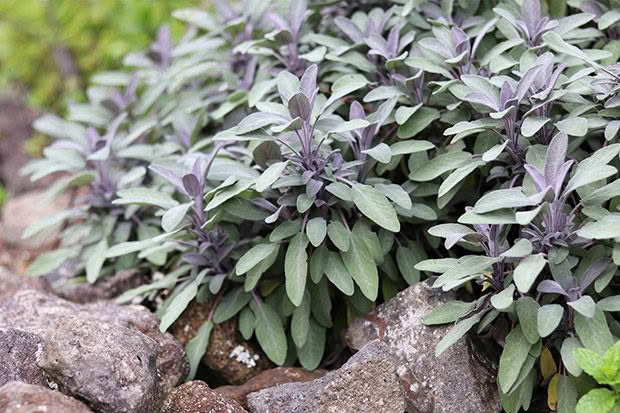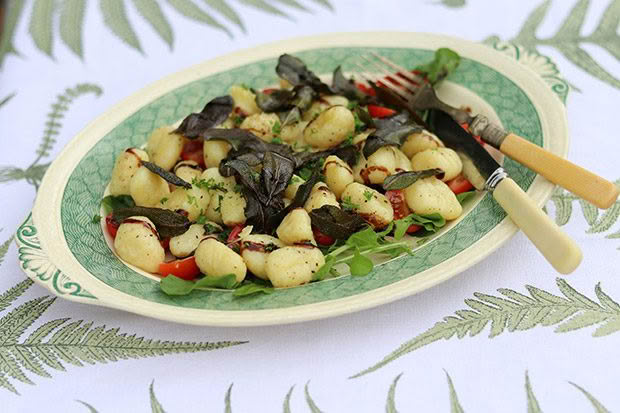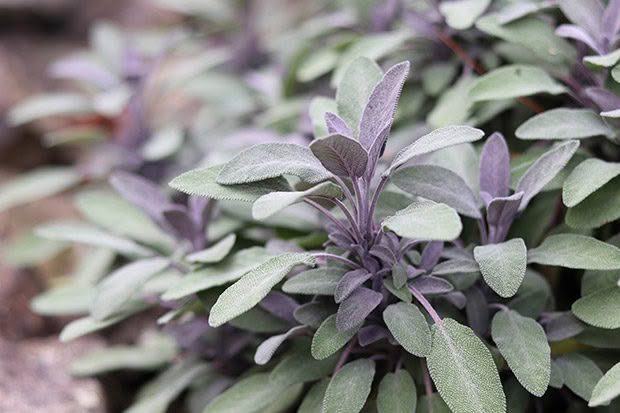Lynda Hallinan’s Blog: Sage advice
Sage is a handy herb but Lynda Hallinan has a hard time keeping it alive.
A wise old sage made me lunch today. Actually, it was a wise old sage bush, a shrubby veteran purple sage, Salvia officinalis ‘Purpurea’, the plush lilac-leafed little sister of common grey-green culinary sage.
It wasn’t a fancy lunch. I work from home. I can’t afford to slouch around the kitchen making posh nosh in the precious few hours that my boys are at school and our house is blessedly quiet, save for two dogs snoring at my feet.
It was a fast lunch. I looked in the fridge, found half a bag of fresh gnocchi and a lump of a butter and thought: “burro bruno e salvia!” (I don’t know about you, but the hungrier I am, the more likely I am to break into impromptu Italian.)
In a frying pan, I burnt the butter (on purpose), bunged in a handful of fresh sage leaves and sizzled them until crispy. I boiled the gnocchi for 60 seconds, drained it and tossed it into the burro bruno e salvia pan for a little dirty dancing. Then I picked a handful of arugula and some ‘Rapunzel’ cherry tomatoes from my garden, added a sprinkle of chopped parsley, a drizzle of balsamic glaze and, with an audience of two drooling dogs, scoffed the lot.

That was five minutes ago. I’m now writing this blog with a renewed appreciation for freelancing (no IT department to tut tut at butter fingers on the keyboard), and for the hearty state of my purple sage; Salvia officinalis gets its scientific name from the Latin salvere, meaning “to save” or “to be in good health”.
Over the years I’ve planted dozens of sage seedlings. I’ve planted plain English sage, Salvia officinalis, golden sage, Salvia officinalis ‘Aurea’, and the pink, purple and cream variegated form ‘Tricolor’, which I dismissed as gaudy until I came across it in a stylish Swedish meadow, mass-planted with feathery bronze fennel.
Sadly, in my garden sage is the maidenhair fern of herbs. Try as a might, I can’t seem to keep it alive for more than a season. It is happy-go-lucky here in a dry summer, attracting a bothering of bees to its blue spires when all is well, but it sulks terribly when the weather turns the soil sodden.
Two summers ago, I planted nine purple sage plants in a ring around my herb garden. Eight died. The sole survivor has since tried to climb out of the garden and now clings desperately to the rock wall around it, the way a child who is still learning to swim refuses to let go of the edge of the pool.

I have a habit of drowning sage bushes. We get too much rain (up to 2400mm per year) and most of it falls in winter, filling our tanks and replenishing Auckland’s water reservoirs while also rotting the roots off all my sun-loving Mediterranean herbs including sage, rosemary, santolina and thyme. I’ve come to accept that, in this climate, I will kill as many sages as I buy, with the only variable being the length of time between shopping bag and compost bin.
Perhaps all those dearly departed sages felt unloved. It shames me to admit that for many years, I only grew sage for its looks (ditto curly parsley, which makes for a decorative frill at the front of a flower bed). The only time I deigned to actually pick sage – and even then, it was only a leaf or two at most – was to stuff it up a roast chook or to soothe a sore throat. But that was before I ordered tortelloni di ricotta con burro e salvia – handmade buffalo ricotta tortelloni with butter and sage – from Auckland Italian eatery Pasta & Cuore. Suffice to say, my sage hasn’t been safe from my secateurs ever since.
I’d like to say that there’s something transcendental about fried sage, but rarely is any food not improved by a hot bath in butter. Frying sage certainly tames the feral pungency of the raw leaves which taste, according to my two boys who are now home from school, like rotten sardines with a sucking-on-your-school-jersey mouthfeel.

(How did I get them to chew on a raw sage leaf, you may ask? Because the last herb I gave them to nibble on was the sweet-as-sugar herb, Stevia rebaudiana.)
I have a raw sage leaf in my mouth now too, and I can confirm that its flavour is not particularly pleasant, tasting a little sour, like eucalyptus, and a little woody, like rosemary, and a little herbaceous, like grass. And yes, I concur, it does taste a smidgen fishy.
Nonetheless, I’m keeping that crushed sage leaf between my lips because I’m getting a cold sore and in 2001, a double-blind randomised trial of alternative remedies found that, when it came to healing them, a sage-leaf and rhubarb-root cream was almost as effective as a tube of Zovirax from the chemist.
I draw the line at digging up my rhubarb to fully test this theory but with the winter cold and flu season coming, a handful of sage is as handy as a face mask. Sage is antiseptic, antibiotic, antioxidant, antihydrotic (stops you sweating) anti-inflammatory, antiviral and anticatarrhal (that means it helps shift mucus from your lungs).
Steep sage leaves with manuka honey and hot water for a sore-throat-soothing herbal tea, or let it cool and use as a cocktail syrup (sage goes nicely with bourbon, gin, tequila and Cointreau), or steep in apple cider vinegar for an immunity-boosting breakfast tonic.
Incidentally, the ancient Greeks and Romans believed that sage symbolised domestic virtue: “it has been said that if sage flourishes in a home garden, it is a sign that the wife is in charge of the household,” notes the Herb Society of America.
Jeepers. I better get to the garden centre and pot up some spare sage plants before the man of the house gets ahead of himself.
MORE HERE
Lynda Hallinan’s Blog: You say tomato, I say make ‘mine a double’

